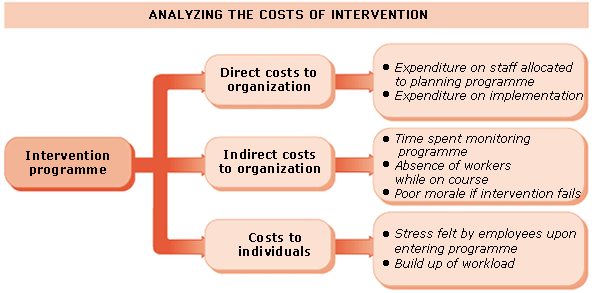An organization that sets out to take positive action on stress at
work must commit itself to the costs involved to reap the full benefits. These
benefits can be measured financially as well as in terms of morale and
increased productivity.
Starting gradually
Taking steps to minimize stress involves change, which itself is
often stressful. Remember that the costs of a stress-management programme can
include poor morale if the scheme fails. Introduce such programmes gradually to
ensure that each step achieves its aim. For example, if employees are given
free membership at a local gym, monitoring the staff usage will provide a good
indication of how popular it is. If the facilities are well used, it might be
worthwhile considering providing an on-site company gym, secure in the
knowledge that it would not be a waste of money.

Committing to change
Stress management is not a quick-fix solution. To be effective,
intervention must extend indefinitely, and the emphasis should gradually shift
from cure of stress to prevention. Initially, the aim should be to reduce
absenteeism by removing or changing the factors that create stress. Once the
drop in absenteeism levels off, the programme should aim to prevent it from
rising again. So, in the early stages the emphasis should be on change, while
later it should be on monitoring and maintaining the wellbeing of staff.
Making changes
The chief executive mentioned in the case study focused on shifting the emphasis from speed to
quality of work, and building team spirit. These measures increased both job
satisfaction and efficiency, and thereby reduced stress levels in the
workforce.
Case study
Mudd & Son, a farm machinery manufacturer, appointed a
forward-thinking chief executive who discovered problems with absenteeism and
low morale among the workers. Employees worked on a piecework system –
those who worked quickly were paid more than those who did not.
The chief executive developed a radical plan for change. The
piecework system was replaced with single-status employment, in which workers
were divided into grades. The better the quality of work, the higher the grade
of pay. She also introduced a bonus scheme rewarding workers’ oustanding
achievement.
Signatures of agreement were obtained from all the employees
before the changes were implemented. This made the workers feel more like a
team, and had a positive long-term effect on output.
Building on success
The case study
discussed here, shows that the company structure was found to be the
cause of falling profits. Although the fundamental changes introduced to
solve the
problem met with resistance, the improved relations between
staff and
management benefited the whole company, lowering stress and
ultimately raising
profits.
Case study
A large electronics company suffered a sharp drop in profit due to
a high staff turnover. A team of management consultants were appointed by the
directors to investigate the problem, and reported too rigid a management
structure and a general lack of communication between staff and management.
Changes to the structure of the company were proposed and
implemented. The consultants then suggested that all employees should go on
team-building courses involving taking part in a range of outdoor
activities.
Despite initial resistance from certain managers, the first course
went ahead. Team members noted an increase in trust and understanding during
the course. Many managers who attended the course also reported improved
working relations with colleagues and junior staff.
TIP
Be aware of your company’s policy on stress management.
TIP
Monitor cases of absenteeism: which days of the week are the
worst?
TIP
Seek out factual evidence for the effectiveness of any
intervention.